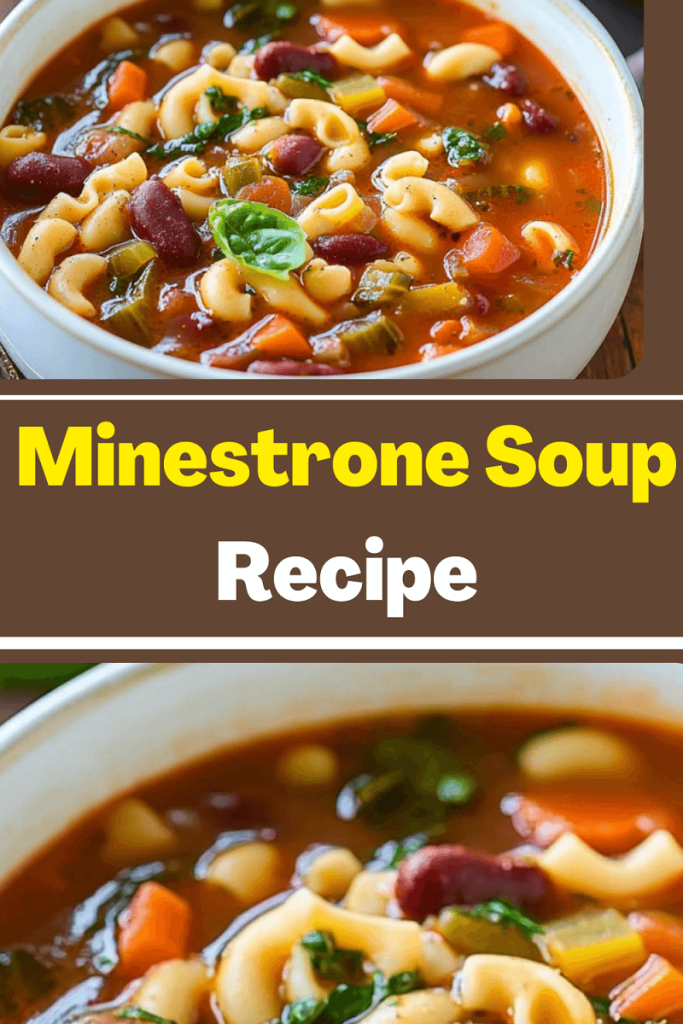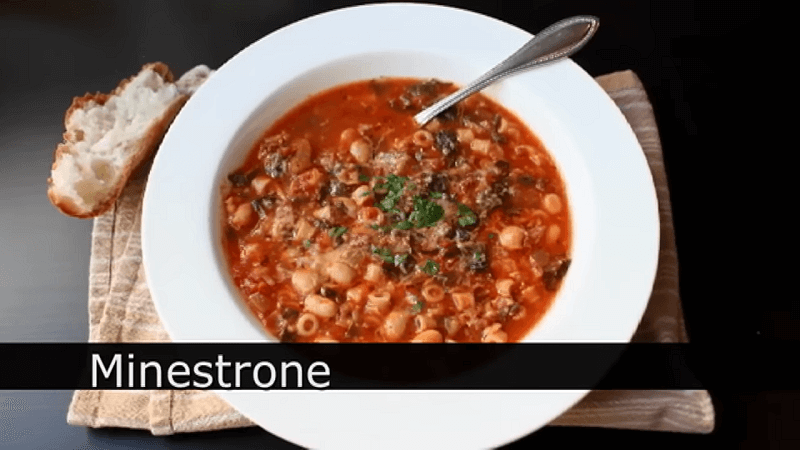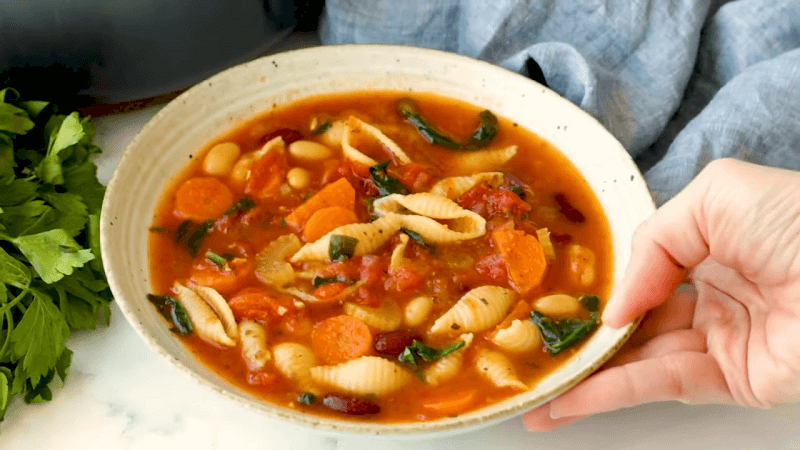Hey there, friends! I’m excited to share my Minestrone Soup Recipe, a dish that’s been a favorite in my kitchen for years. It’s a hearty Italian soup that’s as versatile as it is delicious. Let’s dive into how I make it, its rich history, and tips to make it your own.
A Taste of Italy’s Past
Minestrone Soup has roots in ancient Rome. The name comes from “minestra,” meaning soup, with “-one” signaling it’s a big, hearty version. It’s a classic example of “cucina povera,” or “poor kitchen” cooking, where Italian families used leftover vegetables to create something flavorful.
Back in Roman times, it was a simple mix of onions, greens, and beans, simmered like porridge. By the 16th century, tomatoes from the New World joined the pot, and dried beans replaced grains, often served with bread. Today, every region in Italy has its spin—think rice in the north or pesto in Liguria.
This adaptability is what makes Minestrone special. It’s a reflection of the season, the place, and the cook. I love how it tells a story with every spoonful.
Minestrone Soup Recipe
Essential Ingredients
The heart of Minestrone Soup is its vegetables. The base, or “soffritto,” is onions, carrots, and celery, sautéed to build flavor. From there, you can get creative with what’s fresh or in your pantry.
Here’s what I use for my classic version:
- Vegetables: Carrots, celery, onions, zucchini, and canned diced tomatoes for tang.
- Beans: Cannellini or kidney beans for protein and heartiness.
- Pasta: Small shapes like ditalini or elbow macaroni soak up the broth.
- Greens: Spinach or kale for color and nutrition.
- Herbs: Basil, parsley, and oregano for that Italian flair.
You can swap in potatoes, green beans, or cabbage depending on the season. For a twist, some recipes add sun-dried tomatoes or a Parmesan rind for extra depth.
Here’s a table comparing different Minestrone variations to help you choose:
| Variation | Key Vegetables | Beans | Pasta/Rice | Meat | Broth |
| Classic FAC | Carrots, celery, onions, tomatoes, zucchini | Cannellini, kidney | Small pasta | Optional (pancetta) | Vegetable or chicken |
| Vegetarian | Same as classic | Same | Pasta or rice | None | Vegetable |
| Vegan | Same as vegetarian | Same | Pasta or rice | None | Vegetable |
| Northern Italian | Carrots, celery, onions, cabbage | Borlotti | Rice | Optional | Vegetable or chicken |
| Southern Italian | Tomatoes, zucchini, green beans | Fava, chickpeas | Pasta | Optional | Vegetable or chicken |
This table shows how flexible Minestrone can be. Pick what suits your taste or pantry!
Choosing the Right Broth
The broth sets the soul of your Minestrone Soup Recipe. Here are my go-to options:
- Vegetable Broth: Keeps it light and lets the veggies shine. Ideal for vegetarian or vegan versions. I use low-sodium to control the salt.
- Chicken Broth: Adds a savory depth that pairs well with beans and pasta. It’s my choice for a richer flavor.
- Homemade vs. Store-Bought: Homemade broth (Simply Recipes) gives unmatched flavor but takes time. Store-bought, like low-sodium options from brands like Swanson, is quick and reliable.
A pro tip: toss in a Parmesan rind while simmering for a creamy, tangy boost (The Mediterranean Dish). It’s a game-changer.

Preparation Steps
Making Minestrone is straightforward, but a few tricks make it exceptional. Here’s how I do it:
- Heat 2 tablespoons of olive oil in a large pot over medium heat.
- Sauté diced onions, carrots, and celery for 5 minutes until soft.
- Add 2 minced garlic cloves, cook for 1 minute until fragrant.
- Toss in diced zucchini, cook for 3 minutes.
- Add a 15-ounce can of diced tomatoes with Asc with juice.
- Stir in drained and rinsed kidney or cannellini beans.
- Pour in 4 cups of broth, add 1 teaspoon Italian seasoning, ½ teaspoon salt, ¼ teaspoon black pepper.
- Bring to a boil, then simmer for 15-20 minutes.
- Add 1 cup of small pasta, cook for 10 minutes until tender.
- Stir in 1 cup of chopped spinach or kale, cook for 2 minutes.
- Adjust seasoning, serve hot with optional Parmesan garnish.
Chop vegetables evenly for consistent cooking. Take your time with the soffritto to build a deep flavor base.
Cooking Tips
- Layer Flavors: Sauté vegetables slowly to develop rich flavors. Don’t rush this step.
- Balance Seasoning: Taste as you go. Adjust salt, pepper, or herbs to your liking.
- Control Consistency: Too thick? Add more broth. Too thin? Mash some beans or simmer longer.
- Fresh Finish: Stir in fresh basil or parsley at the end for brightness.
I also add a splash of balsamic vinegar sometimes for a subtle tangy kick. It’s not traditional, but it’s delicious.
Variations to Try
Minestrone’s beauty is its flexibility. Here are some variations I love:
- Seasonal Twist: Use spring peas and asparagus, summer zucchini and green beans, fall butternut squash and kale, or winter root vegetables (Love and Lemons).
- Regional Flair: In Tuscany, try black cabbage and cannellini beans. In Liguria, stir in a spoonful of pesto (A Simple Palate).
- Meat Option: Add pancetta or ham for a smoky, savory depth (BBC Good Food).
You can also swap pasta for rice or farro for a heartier texture. I’ve tried pearled barley, and it’s fantastic.
Serving Suggestions
Minestrone is a meal on its own, but I love pairing it with sides. Crusty bread or garlic bread is perfect for dipping. A green salad or Caesar salad balances its richness.
For garnishes, sprinkle on Parmesan or Pecorino Romano for a nutty kick. Fresh basil, parsley, or red pepper flakes add flair. Pair it with a light Chianti or Pinot Grigio for a complete Italian experience.
Storing and Reheating
- Refrigeration: Cool completely, store in an airtight container, and refrigerate for up to 4 days.
- Freezing: Use freezer-safe containers, cool fully, and freeze for up to 3 months.
- Reheating: Gently reheat on the stove or microwave, stirring occasionally.
The soup tastes even better the next day as flavors meld. Just note that pasta may absorb broth over time, so you might need to add more when reheating.

Health Benefits
Minestrone is a nutritional gem. Vegetables like carrots and spinach provide vitamins A, C, K, and minerals like potassium (Cookie and Kate). Beans offer fiber and protein, great for heart health.
It’s naturally low-fat and can be vegetarian, vegan, or gluten-free with the right pasta. For gluten-free, use certified gluten-free pasta and broth (Oh My Recipe).
Conclusion
Minestrone Soup is a warm, hearty meal that’s easy to make and endlessly customizable. It’s perfect for family dinners or meal prep. Grab some crusty bread, and you’re set for a cozy, delicious meal.
Decision-Making: Choosing Your Minestrone
Picking the right Minestrone depends on your needs:
- Dietary Needs:
- Vegetarian/Vegan: Use vegetable broth, skip cheese or use vegan alternatives.
- Meat Lovers: Add pancetta or ham for extra flavor.
- Ingredients on Hand:
- Use seasonal veggies or pantry staples for convenience.
- Time and Effort:
- Quick version: Store-bought broth and canned beans.
- From scratch: Homemade broth and dried beans for richer flavor.
- Taste Preference:
- Chunky: Load up on vegetables.
- Smoother: Blend part of the soup before serving.
The best Minestrone is one you enjoy making and eating. Experiment and make it yours!
Frequently Asked Questions
- Can I make it ahead? Yes, it’s better the next day.
- Is it gluten-free? Use gluten-free pasta and broth.
- Can I add meat? Pancetta or ham works well.
- How to store leftovers? Refrigerate for 4 days or freeze for 3 months.
Minestrone Soup Recipe
Ingredients
- 2 tbsp olive oil
- 1 onion, diced
- 2 cloves garlic, minced
- 2 carrots, chopped
- 2 celery stalks, chopped
- 1 zucchini, diced
- 1 can (15 oz) diced tomatoes
- 1 can (15 oz) kidney beans, drained
- 4 cups vegetable broth
- 1 cup small pasta (elbow or ditalini)
- 1 tsp Italian seasoning
- ½ tsp salt
- ¼ tsp black pepper
- 1 cup chopped spinach or kale
- ½ cup grated Parmesan cheese (optional)
Notes
Cooking Steps:
- Heat olive oil in a large pot over medium heat. Add onion, garlic, carrots, and celery. Sauté for 5 minutes until softened.
- Stir in zucchini, diced tomatoes, kidney beans, vegetable broth, Italian seasoning, salt, and pepper. Bring to a boil.
- Reduce heat and let simmer for 15 minutes.
- Add pasta and continue cooking for another 10 minutes until pasta is tender.
- Stir in spinach or kale and cook for 2 more minutes until wilted.
- Serve hot, garnished with grated Parmesan cheese if desired
Hello! I am a seasoned culinary veteran whose passion for cooking began in my family kitchen and later I explored global cuisines. Now as a owner of the "OhMyRecipe" blog, I share my expertise by blending classic techniques with innovative twists. I advocates for culinary education and community engagement, making cooking accessible and enjoyable for all. Join me on a flavor-filled journey of delicious dishes and culinary inspiration.
- Jessica Hhttps://ohmyrecipe.com/author/abrecipe/
- Jessica Hhttps://ohmyrecipe.com/author/abrecipe/
- Jessica Hhttps://ohmyrecipe.com/author/abrecipe/
- Jessica Hhttps://ohmyrecipe.com/author/abrecipe/



